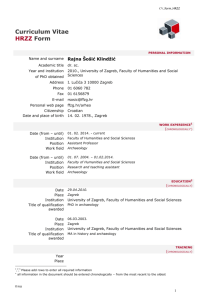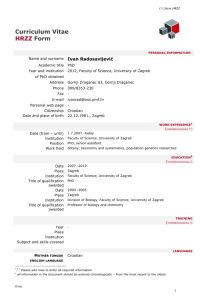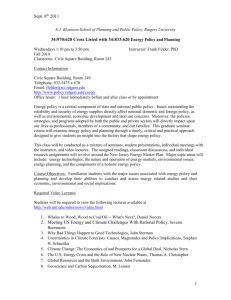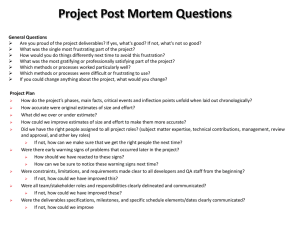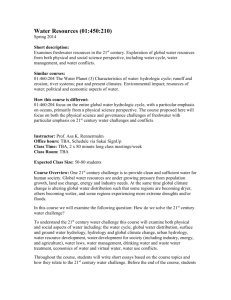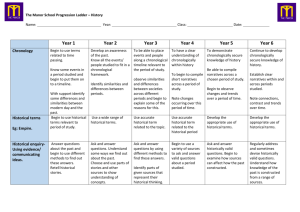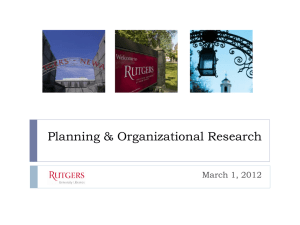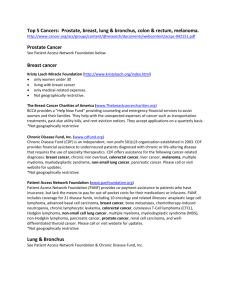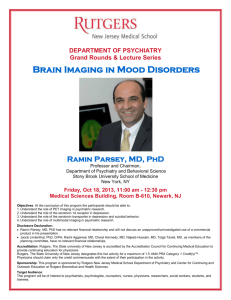HISTORY AND THE NEWS
advertisement
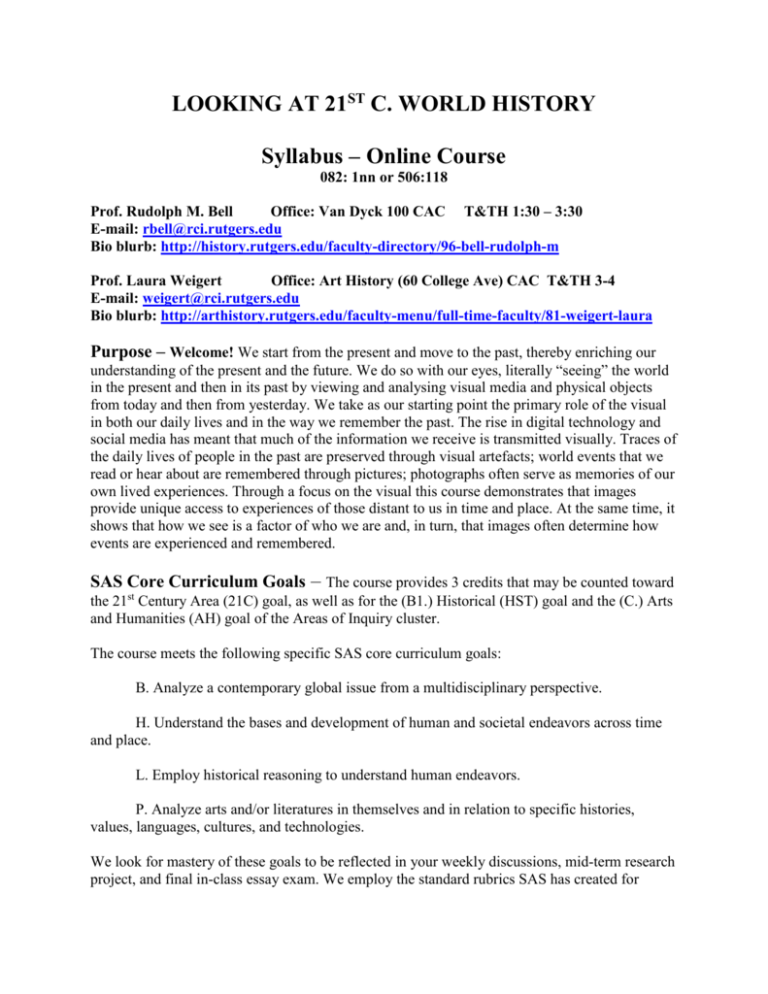
LOOKING AT 21ST C. WORLD HISTORY Syllabus – Online Course 082: 1nn or 506:118 Prof. Rudolph M. Bell Office: Van Dyck 100 CAC T&TH 1:30 – 3:30 E-mail: rbell@rci.rutgers.edu Bio blurb: http://history.rutgers.edu/faculty-directory/96-bell-rudolph-m Prof. Laura Weigert Office: Art History (60 College Ave) CAC T&TH 3-4 E-mail: weigert@rci.rutgers.edu Bio blurb: http://arthistory.rutgers.edu/faculty-menu/full-time-faculty/81-weigert-laura Purpose – Welcome! We start from the present and move to the past, thereby enriching our understanding of the present and the future. We do so with our eyes, literally “seeing” the world in the present and then in its past by viewing and analysing visual media and physical objects from today and then from yesterday. We take as our starting point the primary role of the visual in both our daily lives and in the way we remember the past. The rise in digital technology and social media has meant that much of the information we receive is transmitted visually. Traces of the daily lives of people in the past are preserved through visual artefacts; world events that we read or hear about are remembered through pictures; photographs often serve as memories of our own lived experiences. Through a focus on the visual this course demonstrates that images provide unique access to experiences of those distant to us in time and place. At the same time, it shows that how we see is a factor of who we are and, in turn, that images often determine how events are experienced and remembered. SAS Core Curriculum Goals – The course provides 3 credits that may be counted toward the 21st Century Area (21C) goal, as well as for the (B1.) Historical (HST) goal and the (C.) Arts and Humanities (AH) goal of the Areas of Inquiry cluster. The course meets the following specific SAS core curriculum goals: B. Analyze a contemporary global issue from a multidisciplinary perspective. H. Understand the bases and development of human and societal endeavors across time and place. L. Employ historical reasoning to understand human endeavors. P. Analyze arts and/or literatures in themselves and in relation to specific histories, values, languages, cultures, and technologies. We look for mastery of these goals to be reflected in your weekly discussions, mid-term research project, and final in-class essay exam. We employ the standard rubrics SAS has created for evaluating how fully students achieve each of the above four curriculum goals. These are woven into your final exam and expected in weekly discussions and your mid-semester research project. Outcomes: Upon successful completion of this course, you should be able to: 1) Demonstrate a sophisticated understanding in identifying, comparing, and contrasting the perspectives of history and art history as disciplines concerned with pressing contemporary global issues related to human bodies, communities, and contacts (particularly emphasized in weekly discussions). 2) Analyze in depth the bases and development of several human and societal endeavors across time and place (particularly emphasized in the final exam). 3) Use historical reasoning and research methods to present a detailed and thorough analysis of an important human endeavor across time and place (particularly emphasized in the mid-term project). 4) Provide a sophisticated analysis of works of art and a critical assessment of the relationship between them and their specific histories, values, and cultures (particularly emphasized in the final exam). Environment: The course is online, except for the required in-person final exam held at a specific time and place at Rutgers University in New Brunswick (time and place to be announced as soon as possible). Lecture: Each week Profs. Bell and Weigert select a 21st century issue of global importance. We examine in depth some aspect of its current visual representation and explore selected parallel historical realities in other geographic settings, also developed primarily from visual evidence. We then gather one or more experts whom we interview using a digital camera. The results are several interview segments, running to a total of approximately 80 minutes, the same overall time as for a face-to-face lecture class. These video segments are uploaded for individual student viewing at your convenience on Sakai by no later than Friday at 4:00 p.m. each week. They remain available for the rest of the semester but should be viewed, along with related materials before discussion begins on the following Wednesday at 10:00 a.m. Readings and Viewings: Also at the beginning of each “week” at 4:00 p.m. on Friday, required and suggested readings and viewings are posted on Sakai, again remaining available for the rest of the semester but should be completed before the weekly discussion begins. Discussion: Beginning on Wednesday at 10:00 a.m. each week, you sign on to Sakai and use the Discussion Tool. The discussion remains open until 4:00 p.m. on Friday, when the topic for the following week opens (see Lecture above). Your contributions to the discussion are graded each week on a scale of 0 to 10. For maximum scores, please sign in at least threes times during the 54-hour time bloc when the discussion is open, posting intelligent interventions that respond in a meaningful way to what your fellow students are posting. This is an asynchronous discussion format and you need to think about how to communicate effectively and interactively in such an online environment. Repeating what already has been said counts for little. Also not good is three quick sign-ins and postings that talk to yourself. Instead, aim for an opening post on Wednesday, a responsive entry on Thursday that reflects and deepens what others already have contributed, and a final entry on Friday that moves you forward to an intellectual place beyond where you started on Wednesday. The key is to go deeply into the week’s materials while you learn from the observations of your fellow students. (You may bring additional materials to the discussion but there is no expectation that you will do so and if you do, you need to tie the added material to what has been assigned for the week.) The discussions will begin each week with a broadly comparative prompt posted as a starting point. The prompt will reflect one or more of the core curriculum goals stated above. The most effective discussions then will “take off” in dynamic, non-repetitive directions. Discussion entries should be concise and highly focused, building upon prior entries by fellow students as these unfold. We expect more than brief tweets. Aim for postings written in proper English, backed by specific evidence, and respectful of other viewpoints. The best 10 of 13 individual participations in discussion will count for 30% of total course grade. Grades are on a ten-point scale where a 10 is fabulous, with 9, 8, and 7 at the A, B, and C level respectively. We will be looking in at the various discussion groups, which consist of ten students each, but guidance and grading will be done by Teaching Assistants selected from among advanced graduate students in Art History and History. They will also be responsible for grading of the two written requirements listed below. Written requirements: (1) Mid-term Research Project. During Week 7 of the course, instead of the usual format, students will complete individual research projects that grow directly out of ONE of the 21st century issues considered in the first six weeks of the course. The project must focus on a time and place not already developed for the chosen issue. It must then specify and analyze carefully one or more visual representations of the issue in the chosen culture and time. The expected result, submitted online through the Assignment Tool, will be a paper based on at least one visual representation and a written analysis of approximately 2000 words. For example, let us say that in Week 3 we explore the 21st c. issue of cancer treatment in Botswana, Africa with Prof. Julie Livingston, as documented with photographs in her 2012 book, Improvising Medicine: An African Oncology Ward in an Emerging Cancer Epidemic. Let us say further that in the same week we consider images of the 14th c. Black Death in Europe with Prof. Sarah McHam, the ten Ancient Egyptian plagues enumerated in the Book of Exodus with Prof. Gary Rendsberg, and the small pox epidemic of 1775-82 in North America with Prof. Peter Silver. Students would then be free for their Week 7 project, and we hope inspired, to develop a project on the visual representation of any epidemic in any place and time in the course of human history, of which there are hundreds if not thousands or tens of thousands. More specific information on the mid-term project, and opportunities for individual consultation, will be available as the semester progresses. This project counts for thirty percent of your overall course grade. (2) A final exam, in-class at a specified time and place in New Brunswick, will cover the themes and specific times/places/episodes/visual representations developed during the course. The exam will be in essay format and will include visual identification and analysis. The final exam counts for 40% of your total grade. Self-Reporting of Absences “Absence” is a bit difficult to define for an online course environment but, in accordance with University policy, if you expect to miss a week’s work entirely, please use the University absence reporting website https://sims.rutgers.edu/ssra to indicate the date and reason for your absence. An email is automatically sent to us. Such reporting does NOT excuse you from the best 10 of 13 rule for Discussion grades. Special Needs: Any student with a disability who needs accommodations should contact one of us as soon as possible. Same holds for other challenges (athletics, personal situations, military call-ups, etc.) Plagiarism and Academic Integrity: Please see the video at: http://www.scc.rutgers.edu/douglass/sal/plagiarism/intro.html We use "Turn it In" and other detection methods to find duplicate papers or work cut and pasted from the Internet. There is no reason and no excuse for failure to do your own work and to do it honestly. We follow a "zero tolerance" policy. Weekly topics (12 tentative examples, plus an introductory Week 1 and a midterm Week 7 project = total of 14 weeks): Unit I: Bodies 1) Body Image Current issues: food and nutrition, anorexia and obesity (Terence Wilson at GSAPP). Chronologically and/or geographically remote: a) textual and visual representations of medieval female saints (Rudolph Bell); b) Angela Howard on images of Buddha in China; d) Sumo wrestling (Don Roden); e) global malnutrition; f) breast feeding. 2) Race and ethnicity Current issues: Foreignness and immigration, passports and identification cards (maybe someone from Newark Criminal Justice) Chronologically and/or geographically remote: a) Irish & Italian immigrants in US and “blackness;” (Virginia Yans) b) Saint Maurice (Tia Kolbaba in Religion); c) Tanya Sheehan on photographic caricatures of race. 3) Sickness Current issues: HIV/Aids (treatment in US and in African countries) (Julie Livingston) Chronologically and/or geographically remote: a)impact of plague on Italian painting (Sarah McHam); b)Leprosy in South Asia and its representation and spatial confinement; (Chie Ikeya) c) menstruation and its representations; (James Reed) d) Tanya Sheehan on her recent book on medical photography, Doctored. 4) Mental Illness Current issues: Insanity and incarceration (someone from the Psych dept) Chronologically and/or geographically remote: a) Carla Yanni on the architecture of insane asylums; b) Gericault’s paintings of the insane; (Matt Matsuda) c) Laura Weigert on Dürer’s Melancholia I; d) Aeschylus’ Oresteian Trilogy in Greek vase painting (John Kenfield) and on stage; e) treatment of mental illness in Russia (Jochen Hellbeck). Unit II: Communities 5) Family Current issues: Gay marriage and adoption (Johanna Schoen). Chronologically and/or geographically remote: a) fertility emblems; b)Nineteenth-century family portraits (Susan Sidlauskas); c) Italian cassoni paintings (Sarah McHam); d) family planning in China (Xun Liu); e) polygamy (Africa, Utah); f) Chinese imperial portraits (Sukhee Lee). 6) Home Current issues: social housing and homelessness (someone in Sociology or GSSW) Chronologically and/or geographically remote: a) Native American dwellings; b) Roman domestic mosaics and Pompeii (Corey Brennan); c) furnishings of bourgeois town houses in early modern Paris (Jennifer Jones); d) spatial layout of African villages (Al Howard). 7) Money Current issues: Wall Street (Zeitgeist II (Addendum)) (James Livingston) Chronologically and/or geographically remote: a) From Medici to Fugger and the creation of currency; (Rudolph Bell) b) representations of Jewish bankers and moneylenders in pictures and on stage; (Nancy Sinkoff) c) creation of the Euro and artistic competition for bill design; d) coinage throughout Roman Empire (Archer St. Clair). 8) Play Current issues: regulations and creativity in playground design, promoting risk taking or safety? (Someone from Childhood Studies program at Camden) Chronologically and/or geographically remote: a) Carnival in Rio de Janeiro; (Gail Triner or Kim Butler) b) Carnival in Venice and its representations (Catherine Puglisi or Benjamin Paul); c) Bruegel’s Children’s Games (Laura Weigert); d) Sport in Ancient Athens and in Roman and Greek sculpture; (Thomas Figueira) e) festival in Quinming scroll (Angela Howard). Unit III: Contacts 9) Communication and writing Current issues: internet and revolution (Dave Carpf in SCI) Chronologically and/or geographically remote: a) Prehistoric Cave Painting; b) Moses, Mary and other recipients of divine missives; (Gary Rendsburg) c) editorials from Erasmus to the New York Times; (David Greenberg) d) Morse code; (Paul Israel) e) hieroglyphs; f) language acquisition; living and the dead in Mexico (Cami Townsend). 10) Travel Current issues: travel of drugs/ travel of people (immigration) (someone in Criminal Justice?) Chronologically and/or geographically remote: a) The Odyssey and homecoming; (Karl Morrison) b) Marco Polo,(Samantha Kelly) and manuscript illuminations in Il Milione; d) the image of the “savage;” (Peter Silver) e) trade in cocoa (Cortés) and coca (contemporary drug cartels) (Gail Triner); f) pilgrimage, relics, and reliquaries (Erik Thuno). 11) Cloth Current issues: Textile Factory Fire in Bangladesh; Nike boycott (Chie Ikeya) Chronologically and/or geographically remote: a) Triangle Shirtwaist fire; (Richard L McCormick) b) Ghandi’s call to boycott imported cloth and its coverage; (Michael Adas) c) The Silk Road; (Peter Golden) d) Islamic textiles and Christian relics; e) African tribal patterns in textiles (Sarah Brett Smith) 12) War and Violence Current issues: the Aurora shooting and the Dark Knight Rises, video games and violence (Norman Markowitz) Chronologically and/or geographically remote: a) Assyrian relief sculpture; b) Bayeux Tapestry and the Battle of Hastings; (James Masschaele) c) Leni Riefenstahl’s Triumph des Willens (Andres Zervigon); d) Francis Ford Coppola’s Apocalypse Now (1979) (Jennifer Mittlestadt). ONLINE and ONTIME: Some online courses offer substantial flexibility about when assignments must be completed but “Seeing 21st c. World History” does NOT. There are fixed time limits for discussion, a heavy penalty for lateness on the mid-term project, and a fixed time for the final exam. If for whatever reason this format does not suit your needs, you should not take this course. HARDWARE NEEDS: MAC or PC both work well but absolutely you need a fast processor and high-speed Internet access, sufficient to view 20-minute and longer video clips (mostly in flv format) on full screen without lengthy delays or dropped connections. SUMMARY OF WEEKLY WORK FLOW: Friday at 4:00 p.m. - Week opens ON SAKAI with videos, readings, and other materials posted. Wednesday 10:00 a.m. through Friday 4:00 p.m. – Online discussion forums take place.
